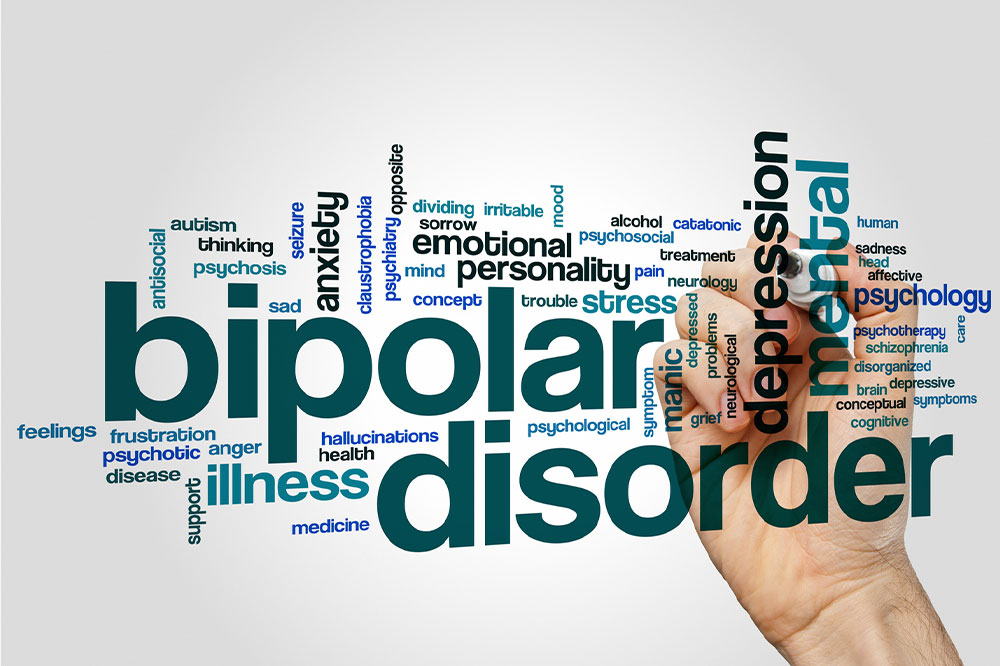
Things to know about bipolar disorder
Bipolar disorder is a mood disorder that causes severe changes in a person’s moods. These mood swings include spells of elevated moods called mania or hypomania and lows or depression. When the affected individual is depressed, they may feel hopeless and uninterested in all activities. Once the mood changes to mania, the individual may feel very energetic, irritable, or euphoric. These mood shifts affect the individual’s quality of life, sleep, behavior, and clarity of thought.
Read to know more.
Causes of bipolar disorder
The exact causes of bipolar disorder are not clear. However, there are factors involved, such as:
Genetics: Bipolar disorder occurs more commonly in people who have a parent or sibling affected by the same condition. Research is still on to determine the genes involved in causing this disorder.
Biological differences: Affected individuals seem to have physical differences in their brains as compared to people without bipolar disorder.
Risk factors
The risk factors for bipolar disorder include:
- Having a close relative affected by the disorder
- High stress and mental trauma
- Substance or alcohol abuse
Types of bipolar disorder:
Bipolar disorder can be of the following types:
Bipolar I disorder: In this type, the affected individual has at least one manic episode or an extreme emotional high. This may be preceded or succeeded by a hypomanic or major depressive episode. Hypomania is less severe than a manic episode.
Bipolar II disorder: People with this type have a major depressive episode lasting at least two weeks. They also experience a hypomanic spell lasting around four days. According to a study, this seems to be more prevalent among women.
Cyclothymia: People with this type of disorder have both depression and hypomania. However, these spells are less severe and shorter than the other two types.
Symptoms of bipolar disorder
Bipolar disorder symptoms include mania, hypomania, and major depressive episodes.
Mania and hypomania
Mania is more severe than hypomania and affects the person’s quality of life and the ability to perform at school or work and causes relationship problems. These two have the same symptoms that include:
- Abnormally happy, excited, or jumpy
- Highly energetic with increased activity
- An exaggerated sense of well-being or euphoria
- Sleeplessness
- Unusually talkative
- Highly distracted
- Poor decision-making abilities – for example, making risky investments, impromptu shopping sprees, or taking sexual risks.
Major depressive episode
A major depressive episode includes symptoms that can severely affect daily activities such as work, social commitments, school, and relationships. Having five or more of these symptoms means that the individual is experiencing a major depressive spell.
- Feeling worthless or inappropriately guilty
- Fatigue and lethargy
- Insomnia or excessive sleep
- Indecisiveness
- Unable to concentrate
- Significant weight loss or weight gain
- Loss of appetite or increased appetite
- Not feeling pleasure in any activity
- Depressed mood, feeling sad, hopeless, and tearful
- Suicidal thoughts
Bipolar disorder in children and teenagers
Bipolar disorders in children and teens can be difficult to diagnose as the symptoms often overlap with conditions such as ADHD or depression. Diagnosing bipolar disorder in children and teens can take months of observation. It is best to seek help from a mental healthcare professional.
Manic symptoms in children include:
- Feeling excessively happy and acting very silly
- Talking fast and quickly changing subjects
- Being unable to concentrate
- Doing risky things
- Having outbursts of anger
- Insomnia or not being tired after sleep loss
Depressive symptoms in children include:
- Acting sad, crying frequently
- Sleeping a lot or too little
- Not showing interest in anything
- Eating too much or too little
- Thoughts of suicide or death
Symptoms in teens
In teens, the changing hormones due to puberty can make them seem extremely emotional at times. However, drastic mood changes could indicate bipolar disorder in teens.
Manic symptoms in teens include:
- Being excessively happy
- Risky behavior like substance abuse
- Being sexually active and taking sexual risks
- Being short-tempered
- Being easily distracted
- Trouble sleeping and not feeling fatigued after sleep loss
Depressive symptoms in teens include:
- Sleeping a lot or very little
- Eating too much or very little
- Extreme sadness
- Withdrawing from friends
- Not taking part in anything
- Suicidal thoughts
Treating bipolar disorder
Bipolar disorder is treatable, and affected individuals can live a fulfilling life if they get proper treatment.
Treatment includes a combination of counseling or psychotherapy, lifestyle changes, and doctor-prescribed mood stabilizers, antipsychotics, and antidepressants.
Psychotherapy includes therapies such as cognitive behavioral therapy, psychoeducation, and social and interpersonal rhythm therapy.
Conclusion
Although bipolar disorder is challenging to live with, it can be managed effectively with help from a mental healthcare professional. Diet and lifestyle changes and regular exercise can also help reduce the severity of the symptoms. If you or your loved ones are suffering from such extreme mood shifts, it is best to consult a doctor who can check for symptoms of bipolar disorder and suggest suitable treatment.




